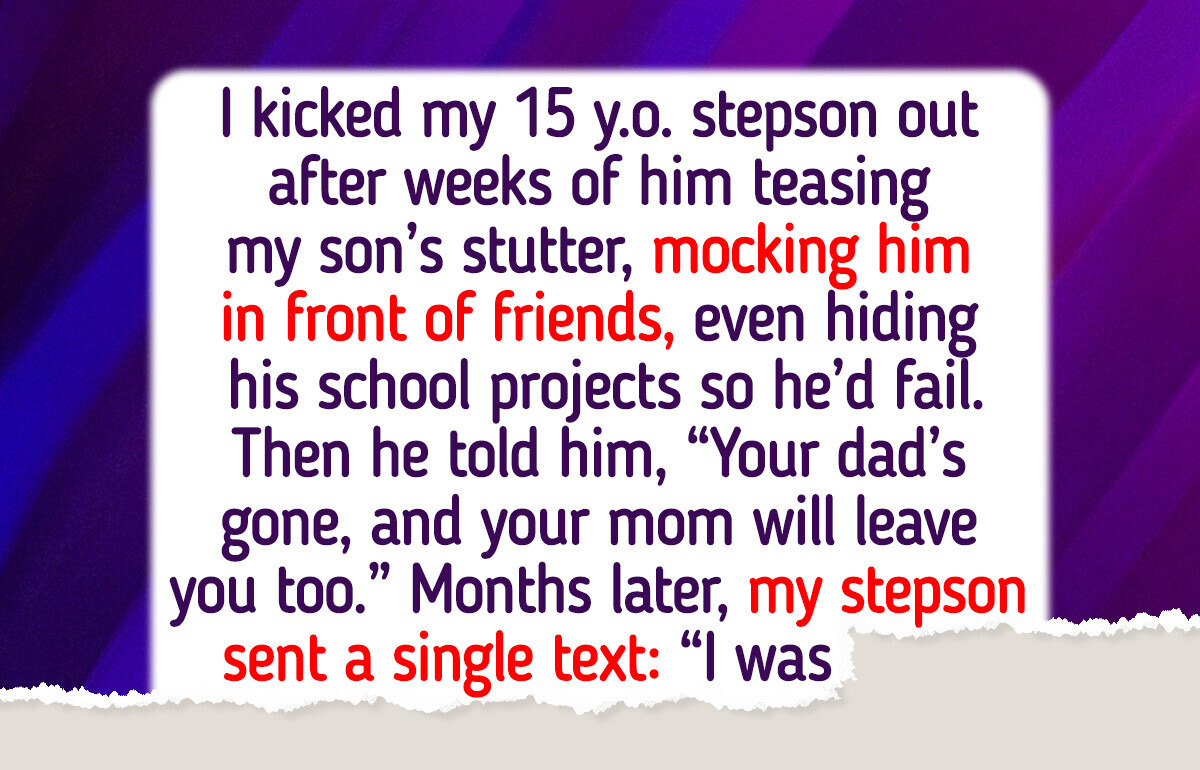Your husband’s parenting style is passive. His attitude would definitely be different if it was his kid being jeered at. Bothering your son that way was not ok, and if dad wants his son around, then he needs to teach proper behavior in a family. It’s a tough situation, requiring more than just going about your regular routines.
I Kicked My Stepson Out—My Son Comes First, and I Won’t Apologize

One of our readers reached out with a story that stopped us in our tracks — a raw, complicated moment where a mother had to make the hardest call of her life. It’s about love, loyalty, and the gut-wrenching reality that sometimes protecting one child can mean losing another. Her words are a reminder that parenting isn’t always about picture-perfect family moments — sometimes it’s about standing your ground, no matter the fallout.
Here is her letter.

“Hi Bright Side!
When my husband’s 15-year-old son, Ryan, moved in, I thought we’d learn to get along. But over time, he started targeting my 14-year-old, Noah — teasing him about his stutter, mocking him in front of friends, even hiding his school projects so he’d fail.
I tried talking to my husband, but he brushed it off as ‘boys being boys.’ Then one night, I overheard Ryan tell Noah, ‘Your dad’s gone, and soon your mom will get rid of you too.’
Noah’s face crumpled. That was it. I told Ryan to pack his bags and go to his mom’s that night. My husband yelled, said I was ‘tearing the family apart,’ but my son’s safety — emotional and physical — comes first.
Months later, Ryan sent a single text: ‘I was just angry Dad left me. Sorry, I took it out on him.’
It didn’t erase what happened. Sometimes protecting one child means losing another.
Anna S.”
Expert tips

Put emotional safety first. A child who feels safe and supported at home carries that strength everywhere else. They walk into new situations with confidence, speak up when they need help, and bounce back from setbacks faster. That sense of security fuels their focus, sharpens their memory, and helps them build stronger friendships — both in and out of the classroom.
Set clear boundaries from day one. In blended families, ground rules aren’t just nice to have — they’re the glue that keeps the peace. Boundaries help reduce conflict, boost cooperation, and make everyone feel like part of the same team.
Get the whole family involved by holding a meeting to talk through the rules together. When everyone shares their thoughts and has a hand in shaping the guidelines, they’re far more likely to respect them. Aim for rules that are SMART — specific, measurable, achievable, relevant, and time-bound — and don’t forget to spell out the consequences for breaking them. Clarity now can prevent chaos later.
Stepparenting without double standards
Many stepparents try to avoid favoritism by holding stepchildren to the same rules and expectations as their own kids. It’s a well-intentioned approach, but it can backfire when children come from households with very different norms.
If a stepchild isn’t used to certain boundaries — like earning dessert by finishing vegetables — they may see equal treatment as unfair treatment. What feels like consistency to you can feel like punishment to them, especially if it contrasts sharply with their previous experience.
Expert tip: In blended families, fairness isn’t always about identical rules from day one. Gradually introduce new expectations, respect the child’s adjustment period, and have the biological parent take the lead on discipline at first. This approach preserves trust while building consistency over time.
Lasting family harmony comes not from treating everyone exactly the same, but from making each child feel equally respected, valued, and safe.
11 Grandparents Who Proved They’re the Real Stars of the Family
Comments
Related Reads
I Won’t Let My Husband and Stepdaughter Name Our Baby

I Refuse to Follow My MIL’s Family Rules During My Vegan Pregnancy, and Now She’s Furious

10 Honest Stories That Capture the Struggles and Pain of Blended Families

My Neighbor Treated My Driveway Like Free Parking, So I Taught Him a Lesson

I Refused to Let Mom Move In With Me—My Privacy Isn’t Up for Debate

14 Acts of Kindness That Turned Total Strangers Into Superheroes

I Refused to Host My Stepdaughter’s Birthday, Now I’m Excluded From the Party

My DIL Excluded Me From Gender Reveal Party, Saying I’m "Not Family"—Big Mistake

My Cousin Refuses to Pay Me After Singing for Her Entire Wedding

I Refuse to Help My Homeless Mom After She Spent All Her Retirement Money on My Sister

I Refuse to Keep Supporting My Daughter and Her 5 Kids for Free

18 Employees Who Saw Their Choices Backfire Hard
